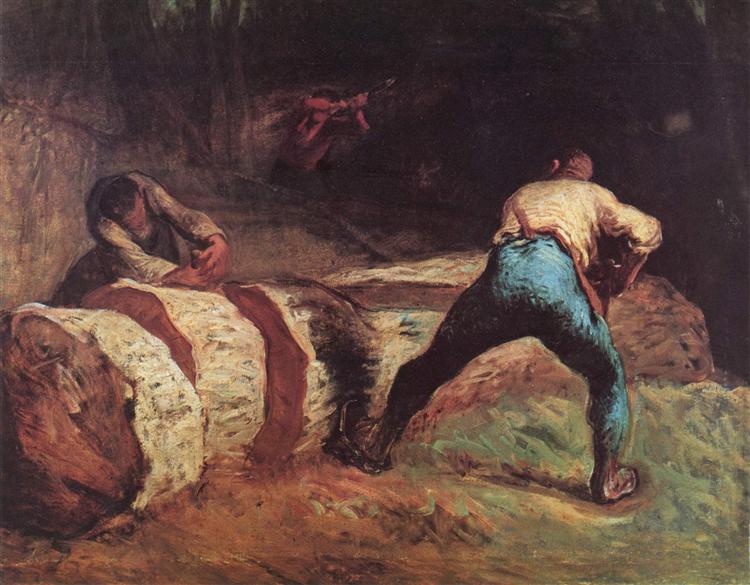説明
Jean-François Millet's The Wood Sawyers (1852) masterfully encapsulates the essence of Realism, a movement that arose in reaction to the idealism of Romanticism. Millet, a pioneer in the depiction of rural life and working-class chores, highlights in this painting the intrinsic dignity of manual labor through the depiction of two men engaged in the task of sawing logs of wood.
The composition focuses on these two sawyers, who, with remarkable concentration, are at the service of nature and work, a recurring theme in Millet's work. The figure on the left holds the saw and leans in a posture that shows the strength and effort required in the task, while the man on the right seems to help stabilize the wood with his foot. This almost everyday gesture reflects the collaboration and community necessary in agricultural work of the time. The closeness between the two characters suggests a camaraderie forged through shared effort, a bond that Millet cleverly portrays.
Millet uses an earthy colour palette, dominated by brown and green tones, evoking the rural environment and underlining the connection between man and the land. The subtly blurred background seems to dissolve into a natural landscape which, although not completely defined, provides a sense of open space and freedom. This use of colour not only contextualises the work in the field, but also brings a serene and contemplative atmosphere to the painting, inviting the viewer to reflect on the simple life and hard work of the peasants.
The characters are particularly significant in this context; their faces, though not fully detailed, convey an expression of determination and industriousness, representing the ethos of the rural man. Through these figures, Millet humanizes the workers, giving them a space and recognition in art that was often denied to them in the society of his time. This approach of placing the rural man at the center of the artistic narrative is a clear precursor to future representations of the working class in Western art.
"The Wood Sawyers" is not just a depiction of two men pushing a saw; it is a testament to man's struggle and tenacity in the face of the elements, an allegory of the work that forms the core of human existence. The attention to detail in the textures of the wood and the worn clothing of the workers offers an intimate glimpse into their lives, while the simplicity of the subject matter contrasts with the richness of the underlying story that surrounds the work.
Ultimately, this painting is a paradigmatic example of Realism. Millet, along with other contemporaries such as Gustave Courbet, helped redefine painting by focusing it on social reality and the human condition. Through his careful attention to everyday life and his sensitivity to the struggles of workers, Millet not only left a mark on the art of his time, but also laid the groundwork for a more humanistic vision in art that would continue to develop in the following centuries. The Woodsawyers therefore stands as a fundamental work that invites today's viewers to reconnect with the essence of human labor and the importance of honoring its roots in the artistic sphere.
KUADROS ©, a famous painting on your wall.
Hand-made oil painting reproductions, with the quality of professional artists and the distinctive seal of KUADROS ©.
Painting reproduction service with satisfaction guarantee. If you are not completely satisfied with the replica of your painting, we will refund 100% of your money.

